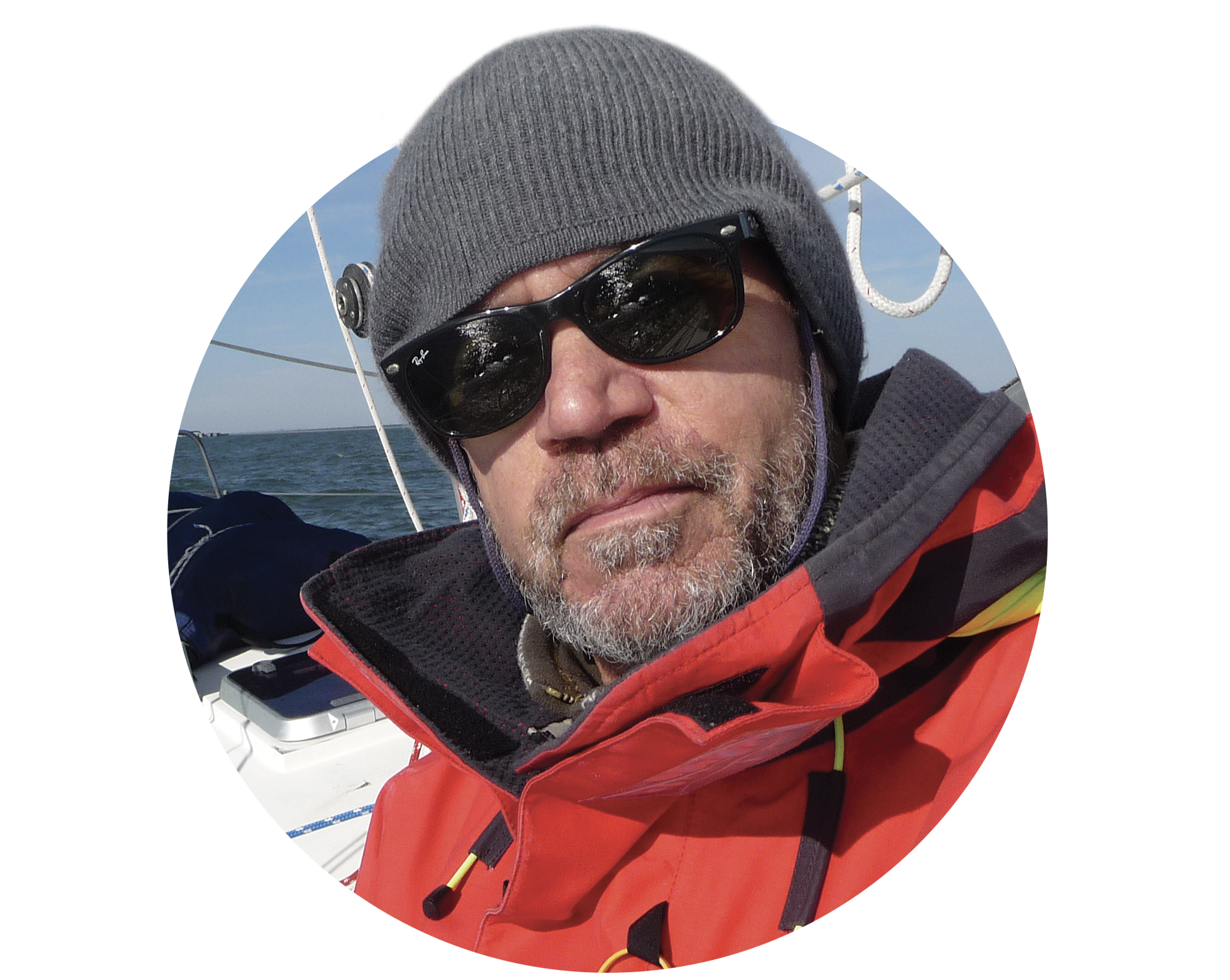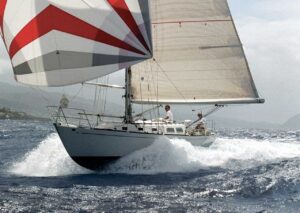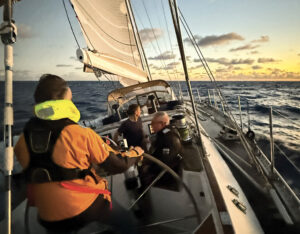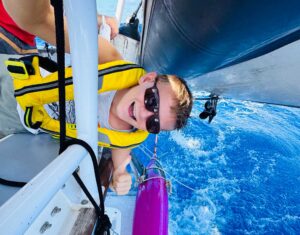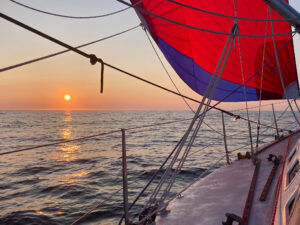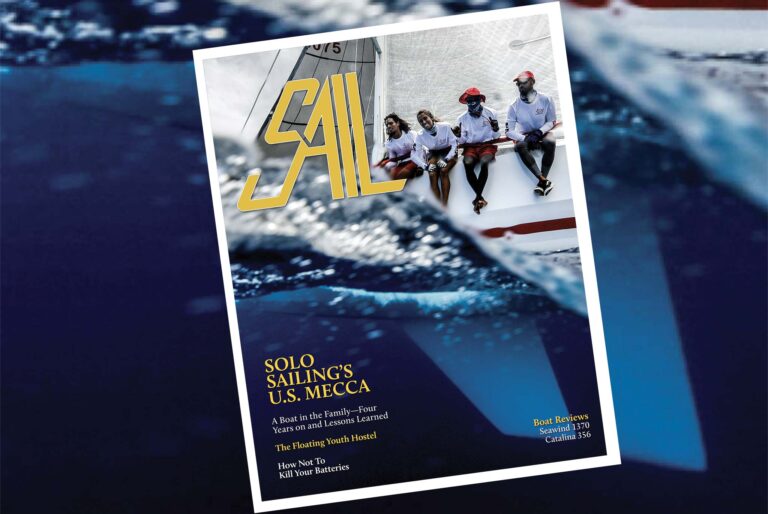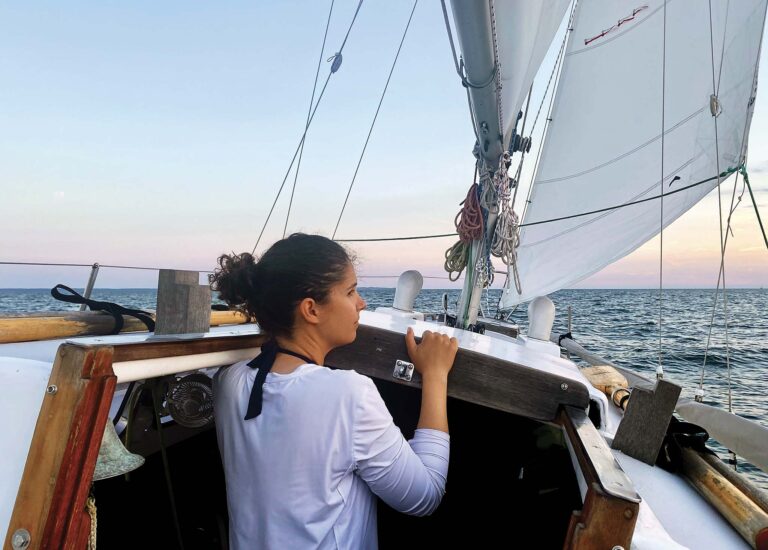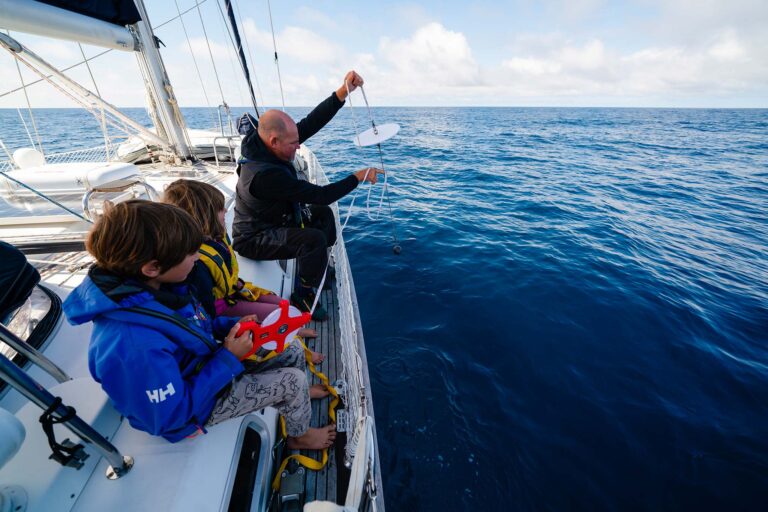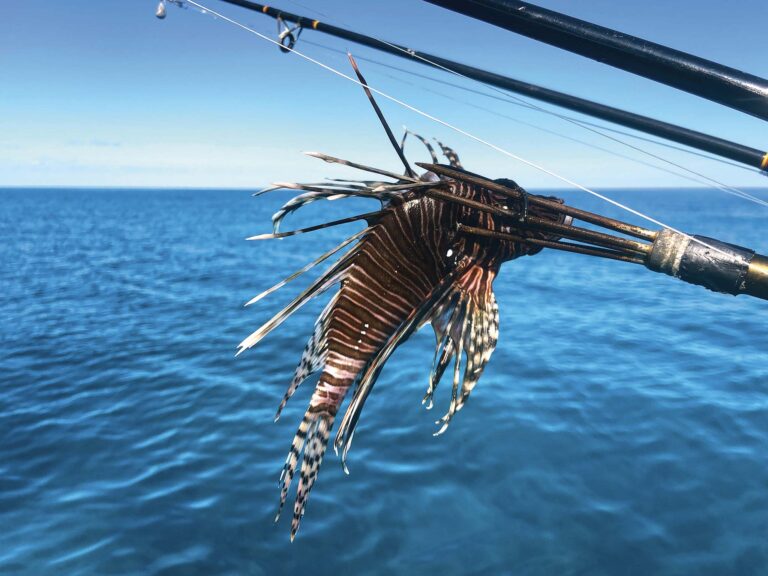
In the early spring of 1893, a seemingly unassuming young man, a clerk who then worked in the British House of Commons, made a fateful decision—he would learn to sail. His name was Erskine Childers. He had a slight build, poor eyesight, a weak chin, and was partly disabled, walking always with a limp to favor his left foot, the result of a hiking injury years earlier. Though he would ultimately lead an eventful and varied life, it was two sailing adventures in particular that made him famous and notorious.
Starting out as a sailor, Erskine literally had no idea what he was doing. Though they had no interest in competitive sailing, he and his equally clueless brother, Henry, purchased as their first boat a large racing yacht, Shulah, with a deep keel and enormous sailplan. They also hired two men to teach them how to manage her. Mocked and humiliated by their professional crew, the brothers soon decided they needed no tutors, fired the crew, and managed to complete a summer’s tour of Ireland and Scotland on their own.
“Memorable was the first morning,” Erskine later wrote, “when we set the sails, weighed the anchor, and glided down the loch, uncriticised, unaided, masters of our fate.”
Realizing how inappropriate Shulah was for cruising, Erskine soon replaced her with a far smaller, equally inappropriate vessel. Marguerite, known affectionately as Mad Agnes, was just 18 feet long, half-decked with no cabin, and drew less than 3 feet with her centerboard up. Erskine fashioned a cockpit tent for shelter and set out on a rather masochistic adventure. Sailing solo and sometimes with crew, he ranged far and wide along the southeast coast of England and twice crossed the English Channel to France. He often anchored out in open, unprotected roadsteads, for as he explained: “I have the strongest antipathy to the dirt, odours, publicity and general discomfort of a quayside berth in a crowded basin.”
At the end of that season, 1895, Erskine was awarded the Admiral de Horsey Silver Cup for best cruise of the year by the Royal Cruising Club, which he had only just joined.

Two years later, in early August 1897, Erskine traded Mad Agnes for a third boat, Vixen, a much more appropriate 30-foot cutter with a centerboard, a proper cabin, and three comfortable berths. “No one could call [her] beautiful,” he later wrote. “We grew to love her in the end, but never to admire her.”
The Riddle of the Sands
Just days after buying this boat in Dover, Erskine set out on a cruise that would change his life. The original goal—the “dream in my heart,” as he termed it—was to sail south and west, down the English Channel, then around into the Bay of Biscay to Bordeaux, then through the Languedoc Canal to the sun-splashed Mediterranean. Step one consisted of Erskine sailing alone across the Dover Strait to Boulogne, where he waited for Henry and a friend to join him. By August 23, all the crew was aboard, but the wind had been blowing foul from the southwest for days.
The following day, with the wind gusting still from the southwest, Erskine and company abandoned their dream of the Med and instead sailed north up the coast toward Holland. They cruised the Dutch canal system and arrived in Amsterdam on September 11, where their third crewmember had to leave them. By September 16, Erskine and Henry had made their way back to open water, on the Dutch coast at Ijmuiden, and were wondering if they should sail west home to England.
But again it was the whim of the wind that decided for them. The breeze was still southwest and strong, so they sailed north and then east inside the long train of Frisian Islands that stand as shields between the northern coasts of Holland and Germany and the open North Sea.
This was a bleak, unpromising cruising ground. Stretching some 150 nautical miles from the northwest corner of Holland to the base of the Jutland peninsula, the so-called Wadden Sea is at low tide simply a vast mudflat, the largest in the world. On a flood tide a shallow-draft vessel might wander a bit, but on the ebb navigation is restricted to a maze of capillary channels branching out from the main arteries leading in from the North Sea between the barrier islands. In those days these channels were poorly charted, marked haphazardly only with long sticks, known as booms or withies, that were driven into the mud. The currents coursing along them are strong and treacherous.
Erskine reveled in all of this. “Body and brain are continually at high tension,” he wrote of the adventure. “Emergency succeeds emergency.” The navigation was an incessant “novel and amusing” puzzle. Running aground and spending hours dried out on the sands, waiting for the tide to return, was a frequent occurrence. The scenery was lonely and monotonous, and as the calendar ran on through all of October and November, and halfway through December, gales came more and more frequently.
These, noted Erskine with some relish in an account he wrote for the Royal Cruising Club, “must generally be met on open anchorages, though in shallow water, harbours (worthy of the name) being very rare.”
During this arduous four-month cruise, Erskine was alone for a good while, as Henry had to leave him at one point. He also did spend some time on the more classically scenic Baltic Sea after transiting Jutland on the Kiel Canal. But it was the Frisian Islands and the barren flats of the Wadden that spoke to his imagination and a certain manic, obsessive trait in his personality.
Ultimately, the experience was put to good use. In 1903, Erskine Childers became an instant celebrity when he published The Riddle of the Sands. This, on the one hand, was a lightly fictionalized account of his cruise on Vixen, well written with evocative descriptions of boathandling and navigation on the Wadden Sea. On the other hand, the details of the cruise were wrapped around a highly dramatic, entirely fictional plot device. Arthur Davies (based closely on Erskine himself), skipper of Dulcibella (based closely on Vixen), suspects a traitorous Englishman posing as a German yachtsman is plotting something with the German military. Eventually, during his cruise, with help from his crew Carruthers, Davies learns the Germans in fact are planning to launch a surprise invasion of Great Britain from their tiny mainland ports on the Wadden Sea.

At the time—with Kaiser Wilhelm rapidly building up the German navy, and with no British ships permanently based in the North Sea—this was an alarming and somewhat believable prospect. The book, which Childers baldly described as propaganda intended to awaken the public to this possible threat, was an overnight smash success. It has also endured as literature, is hailed by some as the first spy novel ever written, is familiar to many sailors and has never been out of print.
Gun Running Under Sail
Erskine Childers had long been a loyal Englishman, born in London and educated in the finest British schools. He not only had served the British Parliament as a clerk, but later was briefly a Member of Parliament himself. His loyalty was clouded, however, after he saw action in the Boer War in South Africa in 1900. His experience in the war, in which proud Boer guerillas were subjugated through ruthless British tactics, caused him to question the legitimacy of Britain’s empire, then at the height of its power.
Erskine’s loyalties were further confused by the fact that his mother’s family, the Bartons, were Anglo-Irish, with an estate in County Wicklow. He spent summers there and for a time actually lived with the Bartons after losing his parents. Ultimately, in 1908, he came out in favor of Irish independence. He was encouraged in this by his Irish cousins and by his new American wife, Molly, whom he met and promptly married during a trip to Boston soon after The Riddle of the Sands was published.
Erskine’s first real opportunity to aid the Irish cause came in the summer of 1914 and involved a fine yacht, Asgard, he and Molly had received as wedding gift from her father. This was a gaff-rigged ketch measuring 44 feet on deck, designed and built by the renowned Colin Archer to Erskine’s specifications.
Ireland by now was on the verge of what was termed Home Rule, an issue that had roiled British politics for decades. In the northeast province of Ulster, however, pro-British Protestants refused to be dragged into independence with the predominantly Catholic south. To prepare for a violent confrontation, if necessary, a paramilitary group known as the Ulster Volunteers managed to smuggle thousands of rifles into Belfast in April 1914. The Irish Volunteers, a similar pro-independence militia in Dublin, were determined to follow suit.

Erskine and Molly not only contributed money to help the Irish Volunteers buy guns, they joined enthusiastically in plotting to smuggle them to Dublin. In May 1914 Erskine traveled to Germany with another man to negotiate the purchase of 1,500 Mauser rifles. He also volunteered to deliver most of these weapons to Ireland aboard Asgard. Another yachtsman, Conor O’Brien, who later became the first Irishman to sail around the world, offered to take the rest aboard his smaller yacht Kelpie.
The famous cruise that led Erskine to write The Riddle of the Sands was the product of his willingness to let weather dictate his course. Now, in this more infamous cruise, he was sailing to a strict schedule. He had laid up Asgard in Conway, on the northern Welsh coast on the western side of Britain, where she had been idle for some time. He had to recommission his yacht in great haste, then was to rendezvous with Conor O’Brien at Cowes, on the south coast of Britain, on July 7, 1914. The two yachts were then to meet a German tugboat, Gladiator, at the Ruytigen lightship off the Belgian coast to collect their illicit cargo on July 10.

The ultimate deadline for Asgard was July 26, a Sunday, when the Irish Volunteers would march out from Dublin to the small harbor of Howth, north of the city, to collect their new weapons. Timing was everything. Howth dried out at low tide, and Asgard, a deep vessel, would only be able to land and then depart at the top of the tide around noon.
All this in a sailing vessel with no engine. No true sailor will be surprised to learn that the weather was bound to be contrary.
Inevitably, there were delays preparing the boat and collecting her crew, and it wasn’t until July 3 that Asgard departed from Conway, struggling to make way against a light headwind. On board were Erskine and Molly, Mary Spring Rice, another Anglo-Irish liberal committed to Irish independence, Gordon Shephard, a British military officer who had sailed with Erskine before, plus two Irish fishermen. Little progress was made that first day and night, and when the wind finally strengthened the next morning, it was still from ahead and kicked up a choppy sea. All the crew, save for Shephard, were soon seasick.
Bucking headwinds and sometimes foul current, it wasn’t until July 6 that Asgard finally cleared the Welsh coast. She spent all the next day beating against a foul southwest breeze, until finally late on the evening of the 7th, she rounded the southwest tip of Cornwall at Land’s End, and her crew were at last able to ease sheets on a broad reach up the English Channel. Cowes, in the middle of the south coast of England, was still 170 miles away.
Asgard finally arrived there, two days behind schedule, early on the morning of July 9. Conor O’Brien, a man renowned for his hot temper, was alongside not long after sunrise, cursing Erskine and demanding to know why they were so late. On going ashore, very fortunately, they found a letter informing them their rendezvous off the Belgian coast was postponed for two days.

Mary Rice, after so many days afloat battling headwinds, also had difficulty walking. “I found I could hardly stand,” she wrote in her diary, “so I tottered to a lamp-post and clung to it regardless of Molly’s protests.”
O’Brien departed Cowes aboard Kelpie early on the morning of July 10. Erskine and crew, after completing some repairs, followed that afternoon on Asgard. Once again the wind was against them. First the breeze was fresh, and the women complained about the motion when the men insisted on raising the topsail to make better time. Then the breeze went light, and the motion improved.
“I came on deck to find Erskine steering in a calm sea,” wrote Mary Rice on Sunday, July 12. “A heavenly summer morning, if one had no gun-running appointments at the Ruytigen lightship, 45 miles away, at 12 noon.”

Meanwhile, down below, other members of the crew were tearing out two bunks in the salon to make room for their cargo.
By noon they were becalmed and still had 20 miles to go. The tension aboard was acute. Then, miraculously, a fair breeze filled in, and they were sailing again at a good clip. But with the breeze came a dense haze as heavy as fog, and they worried they would never find the tug Gladiator. Molly, fortunately, had keen eyes, and after a long anxious interval, she finally spotted something—a pale silhouette of a tugboat with a small yacht alongside. Just as Asgard sailed up, O’Brien aboard Kelpie pushed off and gave them a hearty wave before disappearing from sight.
Packing the guns aboard was no easy job. O’Brien, it turned out, hadn’t room for all the rifles he was meant to carry, and Erskine, ever the fanatic, insisted they would somehow fit all the remaining cargo aboard Asgard. The guns were wrapped in straw and canvas, and to make room for them all this had to be stripped off before the rifles were handed below. It took five hours to stow them all, along with 29 boxes of ammunition. By the time they were finished, the yacht’s interior was filled with rifles stacked two-and-a-half feet high. Asgard, Erskine estimated, was down on her lines by 18 inches.
The wind had by then died entirely, and Erskine eagerly accepted Gladiator’s offer to tow them as far as Dover.
From Dover, heading west back toward Ireland, Asgard once again was confronted with headwinds. And her crew somehow had to function in spite of all the contraband aboard. “Below decks we sleep, crawl over, sit on, eat on guns,” wrote Molly in her diary. “Guns everywhere…but we are all so happy and triumphant, so proud of ourselves, that we swear we are comfortable.”
Soon enough, the wind came fair and good progress was made. By the night of July 17, they had made it as far as Plymouth, at the west end of the English Channel. Here suddenly they found themselves surrounded by the Royal Navy, engaged in night exercises. The huge black shapes of warships towered over Asgard, and one destroyer suddenly turned and made straight for her. Erskine wondered if they would be boarded and the guns discovered, then worried they might instead be run down. Thankfully, the destroyer swerved away at the last moment and left them rolling in her wake.

In the early morning of Sunday, July 19, they were back in Wales and had anchored at Milford Haven. Here they put Gordon Shephard ashore, as his leave was almost over and he needed to rejoin his unit. Erskine had planned to spend two nights here, to give his crew a rest and some shore time, but the following afternoon a strong wind sprang up from the east, and Asgard’s anchor began dragging. Once sails were hoisted so the boat could maneuver, Erskine saw no point in re-anchoring. This was a fair breeze that would speed Asgard north up the Welsh coast, and he felt they must take advantage of it. Perversely, of course, the wind soon died, and for 24 hours Asgard lay motionless and becalmed.
The wind at last did revive, and by Wednesday, July 23, Asgard was anchored outside Holyhead, further north up the Welsh coast, just across the Irish Sea from Dublin. Erskine had just fallen asleep below, but soon was roused again, as the local coast guard had come alongside asking questions. Fearing once more Asgard might be boarded and the guns discovered, Erskine shouted out prompt answers and kept his fingers crossed.
“To our immense relief,” wrote Mary in her diary, “they rowed away, and we breathed again.”
The following day it was raining and blowing hard from the southwest. It was still blowing hard the day after that, Friday, July 25, and Erskine decided they had no choice but to strike out west across the Irish Sea, to be sure of making Howth by noon on Sunday. The mainsail promptly ripped in two. They put back to Holyhead, and Molly and Mary spent hours on deck in the rain, stitching the sail back together. As soon as they were done, Asgard sailed west again.
The wind veered northwest, subsided a bit, then blew as a full gale, one of the worst storms to plague the Irish Sea since 1882.
“It was an awful night,” Mary wrote. “Erskine stayed on deck the whole time; the waves looked black and terrible and enormous and though everything was reefed one wondered if we should ever get through without something giving way.”
Incredibly, Asgard made progress and landed on schedule at Howth Sunday at noon. They were greeted by the joyous Irish Volunteers, and in just 45 minutes all the rifles and ammunition were off-loaded.
This, as it turned out, was the last cruise Erskine Childers ever made under sail.

A Violent End
Just a week after Erskine landed his guns at Howth, and Conor O’Brien landed his at Kilcoole, south of Dublin, World War I broke out. The British promptly tabled the question of Irish independence, and Erskine Childers just as promptly signed up to serve in the British military. He served with distinction throughout the war. The apparent contradiction here was integral to Erskine’s nature. “I believe I want action more than anything,” he once wrote. “It has always been best for me.”
In the middle of the war, the guns Erskine had smuggled into Ireland were turned against the British in the violent Easter Rising of 1916. The harsh British response, executing several Irish nationalists without trial, radicalized the Irish nation. And as soon as the war was over, Erskine Childers was right by their side, struggling against British oppression in Ireland.
Erskine’s great adventure running guns to Ireland made him a hero to some Irish nationalists; others always thought he must be a British spy. He played a significant role in the Irish war for independence and became close to the two great leaders of the cause, Eamon de Valera and Michael Collins.
After a cease-fire was called in July 1921, Erskine served as secretary to the Irish delegation, led by Collins, that was sent to London to negotiate peace. Ironically, as soon as the treaty with the British was signed, Erskine joined de Valera in coming out against it. As a younger man he had argued Ireland should rule itself as a member of the British Commonwealth. And this is precisely what the treaty achieved. But now, in the ultimate crisis, his obsessive nature, or his raw need for action, led him to oppose the new Irish government led by Michael Collins and Arthur Griffith. He joined the most radical nationalists and insisted Ireland should be entirely separate from the British Empire.

In the bitter civil war that ensued, Erskine was taken prisoner by the provisional Irish government, accused of carrying a gun, a small souvenir pistol Michael Collins had given him previously. He was promptly tried by a military court and sentenced to death.
Winston Churchill, who sat across from Erskine at the negotiating table in London, was pleased by this. “I have seen with satisfaction,” he wrote, “that the mischief-making murderous renegade, Erskine Childers, has been captured.” He went on to describe him as “this strange being, actuated by a deadly and malignant hatred for the land of his birth.”
On November 24, 1922, Erskine was led out before an Irish firing squad. He limped forward and shook hands with each member of the squad in turn. Then he urged them to move a step or two closer, so it would be easier for them to shoot and kill him.
Asgard: A Place in Irish History
Though Erskine Childers fought against and was executed by the government of the Irish Free State, his memory and the role he played in achieving independence are today honored in Ireland. Enough so that his son, Erskine Hamilton Childers, was elected Ireland’s fourth president in 1973.
The doughty ketch in which Erskine smuggled guns to Ireland has likewise been honored. Soon after the run to Howth in 1914, Asgard was laid up in Wales and sat idle until finally Molly Childers sold her in 1928. Asgard subsequently belonged to a series of private owners, one of whom installed an engine in the ketch in 1932. Molly publicly decried this as “a degrading action.”
In 1960, after years of neglect, Asgard was purchased by the Irish government and was refit as the nation’s first sail training vessel. In 1961, she sailed triumphantly back into Howth and was greeted by surviving Irish Volunteers who had received guns from her in 1914. In 1974, Asgard was retired from active service. From 2007 to 2012, Asgard was the subject of a major conservation program and is now on permanent display in a dedicated building at the Irish National Museum at the Collins Barracks in Dublin.

June/July 2024
